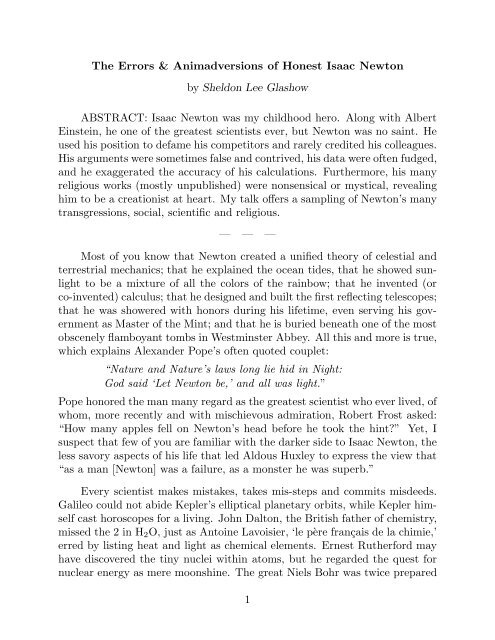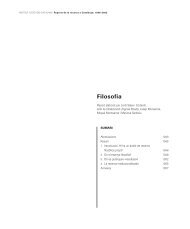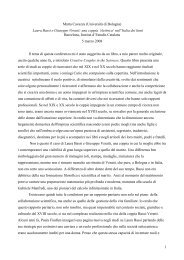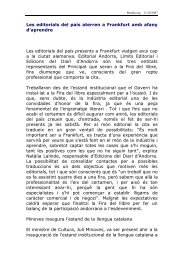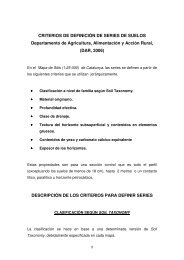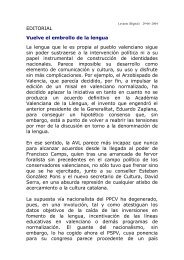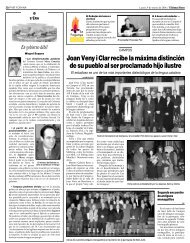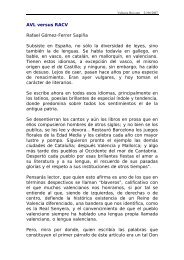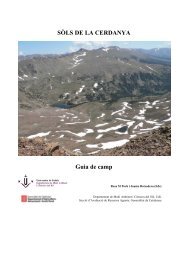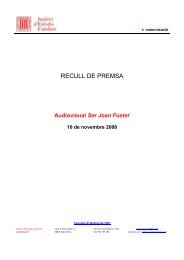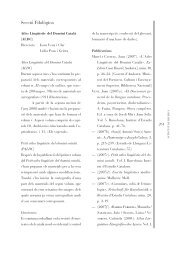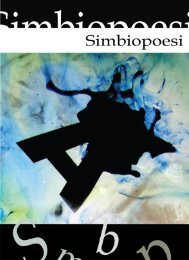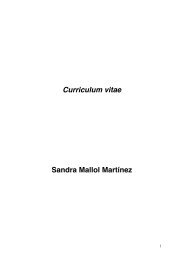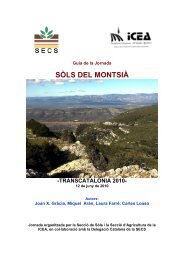The Errors & Animadversions of Honest Isaac Newton by Sheldon ...
The Errors & Animadversions of Honest Isaac Newton by Sheldon ...
The Errors & Animadversions of Honest Isaac Newton by Sheldon ...
Create successful ePaper yourself
Turn your PDF publications into a flip-book with our unique Google optimized e-Paper software.
<strong>The</strong> <strong>Errors</strong> & <strong>Animadversions</strong> <strong>of</strong> <strong>Honest</strong> <strong>Isaac</strong> <strong>Newton</strong><strong>by</strong> <strong>Sheldon</strong> Lee GlashowABSTRACT: <strong>Isaac</strong> <strong>Newton</strong> was my childhood hero. Along with AlbertEinstein, he one <strong>of</strong> the greatest scientists ever, but <strong>Newton</strong> was no saint. Heused his position to defame his competitors and rarely credited his colleagues.His arguments were sometimes false and contrived, his data were <strong>of</strong>ten fudged,and he exaggerated the accuracy <strong>of</strong> his calculations. Furthermore, his manyreligious works (mostly unpublished) were nonsensical or mystical, revealinghim to be a creationist at heart. My talk <strong>of</strong>fers a sampling <strong>of</strong> <strong>Newton</strong>’s manytransgressions, social, scientific and religious.— — —Most <strong>of</strong> you know that <strong>Newton</strong> created a unified theory <strong>of</strong> celestial andterrestrial mechanics; that he explained the ocean tides, that he showed sunlightto be a mixture <strong>of</strong> all the colors <strong>of</strong> the rainbow; that he invented (orco-invented) calculus; that he designed and built the first reflecting telescopes;that he was showered with honors during his lifetime, even serving his governmentas Master <strong>of</strong> the Mint; and that he is buried beneath one <strong>of</strong> the mostobscenely flamboyant tombs in Westminster Abbey. All this and more is true,which explains Alexander Pope’s <strong>of</strong>ten quoted couplet:“Nature and Nature’s laws long lie hid in Night:God said ‘Let <strong>Newton</strong> be,’ and all was light.”Pope honored the man many regard as the greatest scientist who ever lived, <strong>of</strong>whom, more recently and with mischievous admiration, Robert Frost asked:“How many apples fell on <strong>Newton</strong>’s head before he took the hint?” Yet, Isuspect that few <strong>of</strong> you are familiar with the darker side to <strong>Isaac</strong> <strong>Newton</strong>, theless savory aspects <strong>of</strong> his life that led Aldous Huxley to express the view that“as a man [<strong>Newton</strong>] was a failure, as a monster he was superb.”Every scientist makes mistakes, takes mis-steps and commits misdeeds.Galileo could not abide Kepler’s elliptical planetary orbits, while Kepler himselfcast horoscopes for a living. John Dalton, the British father <strong>of</strong> chemistry,missed the 2 in H 2 O, just as Antoine Lavoisier, ‘le père français de la chimie,’erred <strong>by</strong> listing heat and light as chemical elements. Ernest Rutherford mayhave discovered the tiny nuclei within atoms, but he regarded the quest fornuclear energy as mere moonshine. <strong>The</strong> great Niels Bohr was twice prepared1
to abandon the law <strong>of</strong> energy conservation and Einstein refused to see Natureas a quantum game <strong>of</strong> chance. More recently, Richard Feynman couldn’tbring himself to call a quark a quark, while T.D. Lee and C.N. Yang, who onceshared a Nobel Prize, barely speak to one another today. <strong>Isaac</strong> <strong>Newton</strong> wasno exception. Not <strong>by</strong> a long shot! Here I shall <strong>of</strong>fer a sampling <strong>of</strong> <strong>Newton</strong>’smany transgressions, social, scientific and religious.1. <strong>Newton</strong> the Tyrant“If I have seen further,” <strong>Newton</strong> famously wrote to his contemporary,Robert Hooke, “it is <strong>by</strong> standing upon the shoulders <strong>of</strong> giants.” No expression<strong>of</strong> humility was this! <strong>The</strong>se men were scientific rivals and bitter enemies.Hooke’s frequent demands for acknowledgement <strong>of</strong> his own significantcontributions to optics and mechanics infuriated <strong>Newton</strong>, who insisted thatHooke’s claims were without merit. Physicist and author Jeremy Bernsteinwrote: “On the face <strong>of</strong> it, <strong>Newton</strong> appears to be calling Hooke a Giant... butthe hyperbole is, after all, addressed to a [quote] ‘crooked little man’.” [<strong>The</strong>Encyclopedia Brittanica describes Hooke’s appearance as “but a sorry show.His figure was crooked [and] his limbs shrunken,” but the amatory exploitsHooke describes in his diaries suggest that he was quite attractive to womenas a young man. Bernstein concludes:] “It was not so much that <strong>Newton</strong>wanted to stand on Hooke’s shoulders, but rather to step on his head.”Most physics students know little <strong>of</strong> Hooke aside from his law aboutsprings, although, as the physicist-historian <strong>of</strong> science Michael Nauenbergnotes, “Hooke was one <strong>of</strong> the most prolific and inventive scientists <strong>of</strong> all time,[making] fundamental contributions to virtually all branches <strong>of</strong> science.” Itis true that Hooke lacked <strong>Newton</strong>’s mathematical sophistication. When heasked <strong>Newton</strong> for mathematical help: “<strong>Newton</strong> solved his problem, but neveracknowledged Hooke’s seminal contributions.” Instead, <strong>Newton</strong> wrote that“[Hooke] has done nothing, and yet written... as if he knew all, [leaving] whatremained to be determined to the drudgery <strong>of</strong> calculations, excusing himselffrom that labor <strong>by</strong> reason <strong>of</strong> his other business, whereas he should ratherhave excused himself <strong>by</strong> reason <strong>of</strong> his inability.” In fact, Hooke had explainedto <strong>Newton</strong> how Kepler’s area law (conservation <strong>of</strong> angular momentum) followsfor any central force. Without this pro<strong>of</strong>, <strong>Newton</strong>’s Principia could nothave been written. “<strong>The</strong> theory <strong>of</strong> planetary motions,” Nauenberg concludes,“should be recognized as a remarkable joint scientific achievement <strong>of</strong> <strong>Newton</strong>and Hooke.”2
We have seen how <strong>Newton</strong>’s relations with Hooke and Leibniz were lessthan cordial. <strong>The</strong>se were not isolated instances <strong>of</strong> <strong>Newton</strong>’s strained interactionswith his peers. William Whiston, like <strong>Newton</strong>, followed the thenhereticalfaith <strong>of</strong> Arianism, today’s Unitarianism, which rejects the doctrine <strong>of</strong>the trinity and denies the divinity <strong>of</strong> Jesus. Whiston was <strong>Newton</strong>’s assistant,later becoming his chosen successor as the Lucasian Pr<strong>of</strong>essor at Cambridge (apost now occupied <strong>by</strong> Stephen Hawking). About a decade afterward, Whistonwas expelled from Cambridge for pr<strong>of</strong>essing the heretical beliefs that <strong>Newton</strong>never abandoned, but had learned to conceal. Later on, when Whiston wasput forward for membership in the Royal Society, <strong>Newton</strong> (as its President)squelched the appointment. Long afterward, Whiston would explain: “If thereader desires to know the reason <strong>of</strong> Sir <strong>Isaac</strong> <strong>Newton</strong>’s unwillingness to haveme a member, he must take notice that [<strong>Newton</strong>] made me his successor; sodid I enjoy a large portion <strong>of</strong> his favour for twenty years together. But hethen perceiving that I could not do as his other darling friends did, that is,learn <strong>of</strong> him, without contradicting him, he could not, in his old age, bearsuch contradiction; and so he was afraid <strong>of</strong> me the last thirteen years <strong>of</strong> hislife.... He was <strong>of</strong> the most fearful, cautious, and suspicious temper, that I everknew.”<strong>The</strong> title <strong>of</strong> this section alludes to the book “<strong>Newton</strong>’s Tyranny: <strong>The</strong>Suppressed Scientific Discoveries <strong>of</strong> Stephen Gray and John Flamsteed.” <strong>by</strong>David and Stephen Clark. Flamsteed, an accomplished cartographer andEngland’s first Astronomer Royal, was charged to produce a catalog <strong>of</strong> thestars. He collected vast amounts <strong>of</strong> data for many years, largely at his ownexpense because <strong>Newton</strong> failed to secure the promised funding. Well beforethe project was completed, and despite Flamsteed’s strong objections, <strong>Newton</strong>had the unfinished manuscript published so that he could make use <strong>of</strong> thedata. Flamsteed managed to acquire and burn hundreds <strong>of</strong> copies <strong>of</strong> theunauthorized document and even brought <strong>Newton</strong> to court. In retaliation,<strong>Newton</strong> had Flamsteed expelled from the Royal Society.Introductory physics textbooks describe how Stephen Gray, an impecuniousdyer and an amateur scientist, discovered how electric charge couldbe conveyed from one body to another distant body through what were latercalled electrical conductors. Gray had the misfortune to be Flamsteed’s corresponentand confidente. <strong>The</strong> friend <strong>of</strong> my enemy is my enemy as well, <strong>Newton</strong>must have felt, because he delayed and opposed the publication <strong>of</strong> Gray’s seminalresearch. Only after <strong>Newton</strong>’s death was Gray awarded the recognition he4
deserved. “Those that have begun to do ill things never blush to do worse tosecure themselves,” Flamsteed later wrote, “Sly <strong>Newton</strong> had still more to doand was ready at coining new excuses and pretences to cover his disingenuousand malicious practices... <strong>Honest</strong> Sir <strong>Isaac</strong> <strong>Newton</strong> (to use his own words)would have all things in his own power, to spoil or sink them...” Flamsteed,it seems, was almost as intemperate and uncompromising as <strong>Newton</strong> himself.2. <strong>Newton</strong>’s Scientific ArroganceLet us examine some <strong>of</strong> <strong>Newton</strong>’s serious scientific blunders, exaggerationsand obfuscations. <strong>Newton</strong> learned <strong>of</strong> Robert Boyle’s great discovery that“there is a spring to the air.” (In fact, it was our friend, Robert Hooke, asBoyle’s assistant, who carried out the experiments.) Imagine a cylinder, theair within confined <strong>by</strong> a freely moveable piston. Push the piston inward andthe compressed air within resists; pull it outward and it also resists. Thus,the device behaves like a rubber band or a spring. <strong>The</strong>se observations are encapsulatedas a quantitative eponymous law: that the pressure <strong>of</strong> a quantity<strong>of</strong> gas is proportional to its density (if — as we now know — the gas is kepta constant temperature).<strong>Newton</strong> sought to deduce Boyle’s Law from first principles. His argumentwent as follows: He imagined a gas to consist <strong>of</strong> a vast multitude <strong>of</strong> tinyparticles. So far, so good. But his gas particles were at rest, “[repelling]each other with forces that are reciprocally proportional to the distances <strong>of</strong>their centres.” He showed that such a system <strong>of</strong> particles would “composean elastic fluid whose density is as the compression.” That is, Boyle’s Lawfollowed from the mutual repulsion <strong>of</strong> air molecules. <strong>Newton</strong> did hedge a bit:“Whether elastic fluids do really consist <strong>of</strong> particles so repelling each other isa physical question. We have here demonstrated mathematically the property<strong>of</strong> fluids consisting <strong>of</strong> particles <strong>of</strong> this kind, that hence philosophers may takeoccasion to discuss that question.”Philosophers (as scientists were then known) have done just that. <strong>Newton</strong>’stiny particles do exist: they are now called molecules. His conjecturedrepulsive force between them, however, would lead to all sorts <strong>of</strong> problems.Fortunately, there is no such force. <strong>Newton</strong>’s explanation <strong>of</strong> Boyle’s law wasdead wrong.A decade after <strong>Newton</strong>’s death, the Swiss scientist Daniel Bernouilli pinpointedthe correct principles underlying Boyle’s Law. Bernouilli’s hypotheticalcorpuscles were not stationary, as <strong>Newton</strong> thought, nor were they subject5
to any mysterious forces. <strong>The</strong>y moved freely and erratically with randomvelocities, occasionally suffering elastic impacts with one another or with thecontaining vessel. But this correct and brilliant insight would languish forwell over a century. “Why was [Bernouilli’s] theory forgotten?” asked thecontemporary historian <strong>of</strong> science Stephen Brush. It was because “<strong>Newton</strong>’stheory... had been firmly established as the explanation <strong>of</strong> Boyle’s Law, both<strong>by</strong> the reputation <strong>of</strong> <strong>Newton</strong> and <strong>by</strong> its simplicity... Once the <strong>Newton</strong>ianswere in power, no prudent scientist (at least in England) would dare to contradictthe real or supposed opinions <strong>of</strong> the ‘autocrat <strong>of</strong> science’ until late inthe 19th century.”<strong>Newton</strong>’s flawed understanding <strong>of</strong> the elasticity <strong>of</strong> air did not preventhim from seeking to understand the propagation <strong>of</strong> sound, which he wrote“can be nothing else but pulses <strong>of</strong> the air propagated through it,” that is,sound waves. From an ingenious but rather difficult to understand argument,he deduced a simple formula for the speed <strong>of</strong> sound in air:V =√PressureDensity .But for a multiplicative factor that is not so different from unity, <strong>Newton</strong>’sresult is correct. It stands as a triumph <strong>of</strong> <strong>Newton</strong>’s physical intuition. Hecould not have known that sound propagation is not isothermal, and that thecorrect result involves an additional thermodynamic parameter.<strong>Newton</strong> would not be satisfied with a result that was only approximatelycorrect. He was compelled to swindle his way to exactitude: Of the precedingcalculation, he wrote, “We have made no allowance for the crassitude <strong>of</strong> thesolid particles <strong>of</strong> the air, <strong>by</strong> which the sound is propagated instantaneously.”(In <strong>Newton</strong>’s time ‘crassitude’ meant ‘thickness’. <strong>Newton</strong> was arguing thatthe physical size <strong>of</strong> air molecules somehow enhanced the velocity <strong>of</strong> sound.)With this dreadfully spurious argument, <strong>Newton</strong> augmented his estimate <strong>of</strong>the speed <strong>of</strong> sound <strong>by</strong> about 10%, but his modified result was still significantlysmaller than its known speed. He then appealed to an even more absurdargument: “<strong>The</strong> vapors floating in the air being <strong>of</strong> another spring, and adifferent tone, will hardly, if at all, partake <strong>of</strong> the motion <strong>of</strong> the true air inwhich the sounds are propagated.... So if the atmosphere consists <strong>of</strong> 10 parts <strong>of</strong>true air and one part <strong>of</strong> vapors [If indeed!], the motion <strong>of</strong> sounds will be swifter<strong>by</strong> the subduplicate ratio [that is, the square root] <strong>of</strong> 11 to 10...” Having6
esorted to the alleged crassitude <strong>of</strong> air and its presumed contamination <strong>by</strong>inert foreign vapors, <strong>Newton</strong> triumphantly boasted <strong>of</strong> an answer that agreedprecisely with the experimentally determined speed <strong>of</strong> sound.Of these manifestly fraudulent arguments, <strong>Newton</strong> scholar Richard Westfallwrote: “Not the least part <strong>of</strong> the Principia’s persuasiveness was its deliberatepretense to a degree <strong>of</strong> precision quite beyond its legitimate claim. If thePrincipia established the quantitative pattern <strong>of</strong> modern science, it equallysuggested a less sublime truth: that no one can manipulate the fudge factorquite so effectively as the master mathematician himself.”Another instance <strong>of</strong> <strong>Newton</strong>’s flawed brilliance concerns his investigation<strong>of</strong> ocean tides, which he showed to result from the gravitational attractions <strong>of</strong>the moon and the sun. “<strong>The</strong> force <strong>of</strong> the moon to move the sea,” he correctlynotes in the Principia, “varies inversely as the cube <strong>of</strong> its distance from theearth.” <strong>Newton</strong> never described how he got this result, and his contemporarieswere at a loss to understand it. Using some rough tidal data, <strong>Newton</strong> found(quite wrongly) that “the moon is more dense than the earth itself.” In 1713,he found the ratio <strong>of</strong> the masses <strong>of</strong> the earth and moon to be 39.371, whereasits actual value is about 81. Here <strong>Newton</strong> asserts five decimal place precisionfor a result that is wrong <strong>by</strong> over a factor <strong>of</strong> two!Even more astonishing was <strong>Newton</strong>’s so-called ‘Moon Test:’ his claimthat the moon, if its orbital motion were stopped <strong>by</strong> some magical agency,would fall toward earth a distance <strong>of</strong> 14.7706353 feet in one minute: ninesignificant figures, <strong>of</strong> which only the first two are correct! As Westfall writes,“<strong>Newton</strong> doctored still another computation in his effort to create an illusion<strong>of</strong> great accuracy.” And yet, let us not forget that <strong>Isaac</strong> <strong>Newton</strong> was the firstperson to provide a correct explanation for why there are two high tides eachday. Many <strong>of</strong> <strong>Newton</strong>’s greatest accomplishments, such as his calculation <strong>of</strong>the speed <strong>of</strong> sound and his studies <strong>of</strong> the tides, are beclouded <strong>by</strong> his tendencytoward specious argumentation and arrogant exaggeration.<strong>Newton</strong> made enormous contributions to the science <strong>of</strong> light. He developeda mathematically precise theory <strong>of</strong> geometrical optics, which led,among other things, to his invention <strong>of</strong> the relecting telescope. He showedhow sunlight, passing through a glass prism, is dissected into its constituentand immutable colors, and how these could be recombined into white light.He explained these phenomena in terms <strong>of</strong> the varying ‘refrangibility’ <strong>of</strong> thedifferent colors <strong>of</strong> light as they pass through a transparent material. (Today7
we would say that the index <strong>of</strong> refraction <strong>of</strong> a material medium is frequencydependent.) <strong>Newton</strong> related the apparent color <strong>of</strong> a body to the degree thatit reflects or absorbs the different colors <strong>of</strong> ambient light. His careful measurements<strong>of</strong> the curious colored patterns produced <strong>by</strong> light reflected from a lensatop a glass plate — which are known as <strong>Newton</strong>’s Rings, although they werefirst described <strong>by</strong> Hooke — suggested to him a flawed analogy between lightand sound, a kind <strong>of</strong> harmony <strong>of</strong> color. Had <strong>Newton</strong> been more open-minded,these studies could and should have led him away from his corpuscular theorytoward a more satisfactory wave theory <strong>of</strong> light, such as had been advocated<strong>by</strong> Hooke and Huygens.But the notion <strong>of</strong> light as a stream <strong>of</strong> material particles was absolutelycentral to <strong>Newton</strong>’s scientific philosophy: “Are not the Rays <strong>of</strong> Light verysmall Bodies emitted <strong>by</strong> shining Substances? For such Bodies will passthrough uniform Mediums in right Lines without bending into the Shadow,which is the nature <strong>of</strong> Rays <strong>of</strong> Light. <strong>The</strong>y will also be capable <strong>of</strong> severalProperties and will be able to preserve their Properties unchanged, which isanother Condition <strong>of</strong> the Rays <strong>of</strong> Light.” <strong>Newton</strong> was stubbornly unwillingto acknowledge the growing empirical evidence, much <strong>of</strong> it his own, that light,under all circumstances then known, behaves as if it were a wave phenomenon.This was the first and foremost <strong>of</strong> his several optical errors.Snell’s law, familiar to all students <strong>of</strong> elementary physics, describes thebending (or, refraction) <strong>of</strong> light rays as they enter or leave a transparentmedium. <strong>Newton</strong> attributed the phenomenon to hypothetical attractive forcesacting between particles <strong>of</strong> light and those <strong>of</strong> matter. Hypothetical forces yetagain! Flushed with pride for his universal law <strong>of</strong> gravitational attraction,<strong>Newton</strong> imagined other forces to lurk everywhere, just as my governmentimagined Iraqi weapons <strong>of</strong> mass destruction: <strong>Newton</strong> proposed a repulsiveforce to explain Boyle’s law, and an attractive force to explain Snell’s law.<strong>Newton</strong>’s widely accepted theory <strong>of</strong> refraction required light to travel fasterthrough glass than air. Not until the mid 1800s was this prediction falsified<strong>by</strong> experiment, putting a full stop to <strong>Newton</strong>’s corpuscular theory. It soonbecame clear to everyone that light is an electromagnetic wave.... Or so itseemed until the 20th century, when we would learn that light is neitherwave nor particle. <strong>The</strong> seemingly paradoxical nature <strong>of</strong> quantum mechanics,however, is the subject <strong>of</strong> quite another lecture.<strong>Newton</strong>’s belief in an exact correspondence between the color <strong>of</strong> light andits refrangibility led him to the false conclusion that a measurement <strong>of</strong> the8
index <strong>of</strong> refraction <strong>of</strong> one color would determine the index for all colors. Hewrote: “Although I have not yet derived the certainty <strong>of</strong> this proposition fromexperiments, nevertheless I do not doubt that it will satisfy all <strong>of</strong> them whichit is possible to do... meanwhile I am content to assume it gratuitously.”<strong>Newton</strong> scholar Alan E. Shapiro claims that: “ When [<strong>Newton</strong>] finally chosethe linear dispersion law in the ‘Opticks,’ [one <strong>of</strong> two mutually inconsistentlaws he had at times proposed,] he supported it with fabricated experimentalevidence.” Incidentally, <strong>Newton</strong>’s theory led him to conclude, indeed, toinsist, that an achromatic lens (one corrected for chromatic aberration) couldnot possibly be fabricated. Not so! It turned out that just such a lens wasdesigned and created soon after <strong>Newton</strong>’s death—<strong>by</strong> the British gentlemanbarrister Chester More Hall... as a hob<strong>by</strong> in his spare time!3. Reason versus Revelation — <strong>Newton</strong> as Creationist<strong>Isaac</strong> <strong>Newton</strong> was not only a physicist and a mathematician. He devotedat least as much <strong>of</strong> his time to alchemical experimentation, religious scholarship,and the study <strong>of</strong> mythology as history, especially biblical chronology.Wisely, <strong>Newton</strong> never published most <strong>of</strong> this nonsense. In his book ‘<strong>Isaac</strong><strong>Newton</strong>, Historian,’ Frank Manuel writes: “Although the content <strong>of</strong> [<strong>Newton</strong>’sunpublished papers] have been generally known for some time... theywere usually avoided as heretical, nonsensical or ‘mystical,’ the dark side <strong>of</strong>the hero...” <strong>The</strong> renowned French scientists Laplace and Biot “took a dimview <strong>of</strong> these writings as dangerous to the course <strong>of</strong> science...” Perhaps, asMarjorie Nicholson says, “<strong>Newton</strong> would have preferred the proud title <strong>of</strong>‘theologian’ to that <strong>of</strong> ‘philosopher’ or ‘scientist’.” Or perhaps, as economistJohn Maynard Keynes suggests, he would better be described as a magician,“because he looked on the whole universe and all that is in it as a riddle, asa secret which could be read <strong>by</strong> applying pure thought to certain evidence,certain mythic clues which God had left about the world... He believed thatthese clues were to be found... partly in certain papers and traditions handeddown <strong>by</strong> the brethren in an unbroken chain back to the original cryptic revelationin Ba<strong>by</strong>lonia.” Today, we might call a person with such beliefs a creationscientist.At age thirty, <strong>Newton</strong> turned his analytical mind to Christian theology.With the passion <strong>of</strong> a rebel, Westfall writes, “<strong>Newton</strong> convinced himself thatthe received tradition was a fraud perpetrated <strong>by</strong> evil men in the fourth centurywho, for their own selfish purposes, had willfully corrupted the entire9
heritage. <strong>Newton</strong>’s determination to unmask this ancient crime... absorbedvirtually all <strong>of</strong> his time for the following fifteen years, until a visit from EdmundHalley [<strong>of</strong> Halley’s comet fame] started the investigation that resultedin the ‘Principia’ and altered the tenor <strong>of</strong> his existence.” We might not fault<strong>Newton</strong> for his closet heresies, nor for his fanciful deduction that the Argonautssallied forth in search <strong>of</strong> the Golden Fleece in 939 BC, nor for hisprediction that the Final Judgement would take place in 1867. But we shallmention some <strong>of</strong> his monumentally hubristic attempts to reconcile his scientificresearches with his firm belief in an active and attentive Deity, one whosestudy, “from the appearances <strong>of</strong> things, does certainly belong to Natural Philosophy.”<strong>Newton</strong> found evidence for the existence <strong>of</strong> God throughout the cosmos.How else could the primal matter <strong>of</strong> the universe have organized itself intoluminous stars and opaque bodies like the planets and their satellites? Howelse could the orbits <strong>of</strong> the planets be made properly spaced and nearly circularso as to ensure the stability <strong>of</strong> the solar system? “This most beautiful system<strong>of</strong> the sun, planets and comets could only proceed through the counsel anddominion <strong>of</strong> an intelligent and powerful Being,” he wrote. Indeed, <strong>Newton</strong>’sGod was very much a scientist in <strong>Newton</strong>’s own image: “To make this systemwith all its motions required a Cause which understood [the various masses,distances, and velocities] <strong>of</strong> the sun and planets.... And to compare andadjust all these things... argues that Cause to be not blind and fortuitous,but very well skilled in Mechanics and Geometry.” Voltaire said it moreelegantly: “L’horloge implique l’horloger,” a clock implies a clockmaker. Buthere lurked a grave theological threat.Although God may have set the universe in motion at the time <strong>of</strong> Creation,could it be that He was no longer needed? Would not <strong>Newton</strong>’s ownlaws suffice to describe an eternal clockwork universe? “To maintain a role forProvidence,” wrote <strong>Newton</strong> scholar David Kubrin, “meant providing essentialchores for God to perform, so that He did not rule over a universe able toexist without Him.”<strong>Newton</strong> knew that the solar system would endure for ‘many ages’ in itspresent form, but he also believed that the small irregularities in planetarymotions and the gravitational effects <strong>of</strong> the planets on one another, “will beapt to increase, til this System wants a Reformation,” and again, “Motionis more apt to be lost than got, and it is always upon the Decay... Seeingtherefore that the amount <strong>of</strong> Motion which we find in the World is always10
decreasing, there is a necessity <strong>of</strong> conserving and recruiting it <strong>by</strong> active principles.”Eventually the clock would run down and the world would tend todissolution, unless the Creator would intervene. Having established the necessityfor God’s continuing attention to the proper running <strong>of</strong> His universe,<strong>Newton</strong> sought the rational means <strong>by</strong> which the Godly reformations were tobe accomplished.At one point, <strong>Newton</strong> appeals to an all-pervading aetherial fluid that isperpetually circulated so as to restore Earth’s rivers and atmosphere, “and asthe Earth, so perhaps may the Sun imbibe this Spirit copiously to preservehis Shining, and keep the Planets from receding further from him... the vastaethereal Spaces between us and the stars [being] a sufficient repository forthis food for the Sun and Planets.”Elsewhere, <strong>Newton</strong> decided upon on comets as the Lord’s agents <strong>of</strong>Earth’s regeneration. <strong>The</strong> appearance <strong>of</strong> cometary tails suggested that theirsubstance is being “scattered through the whole heavens, and <strong>by</strong> little andlittle... attracted toward the planets... and mixed with their atmosphere...[so as to replenish] the fluids spent upon vegetation and putrefaction... <strong>The</strong>fluids, if they are not supplied from without, must be in continual decrease,and quite fail at last. I suspect that it is chiefly from comets that spirit comes[which is] so much required to sustain the life <strong>of</strong> all things with us.”Likewise, <strong>Newton</strong> enlisted comets to restore and renew the sun and thestars: <strong>The</strong> comet <strong>of</strong> 1680 (Halley’s comet, an earlier passage <strong>of</strong> which Halleyclaimed to have been responsible for the biblical Flood,) “must have sufferedsome resistance and retardation; and therefore... will at last fall down uponthe body <strong>of</strong> the sun... So fixed stars, that have been gradually wasted <strong>by</strong>the light and vapors emitted from them for a long time, may be [renewed]<strong>by</strong> comets that fall upon them; and from this fresh supply <strong>of</strong> new fuel thoseold stars, acquiring new splendor, may pass for new stars.” Indeed, <strong>Newton</strong>conjectured that the supernovae observed <strong>by</strong> Tycho and Kepler had resultedfrom such cometary impacts. As Kubrin writes, <strong>Newton</strong> “was able to accountfor both the periodic recruiting <strong>of</strong> motion and activity for the sun and planetsand the ‘reformations’ necessary to reset the system from time to time.[Although] such revolutions were accomplished <strong>by</strong> mechanical means, <strong>Newton</strong>believed that they were under divine supervision.”Kubrin finds that “<strong>Newton</strong>’s ideas implied the existence <strong>of</strong> Earths beforethis one, with the presence <strong>of</strong> races <strong>of</strong> man before Adam, and it seemed11
probable [to <strong>Newton</strong>] that the creation <strong>of</strong> Earth described in Genesis was onlyone in a series <strong>of</strong> Creations.” (<strong>The</strong> Aztecs, incidentally, held a similar butmore explicit view: that the world had been created and destroyed four timesbefore its current incarnation.) As for the future, <strong>Newton</strong> helpfully suggestedthat “the Satellites <strong>of</strong> Jupiter can take the places <strong>of</strong> Earth, Venus, Mars ifthey are destroyed, and be held in reserve for a new Creation.” Dangerousthoughts these! <strong>Newton</strong> never dared publish his unorthodox cosmogony, whichact would certainly have jeopardized his position, and perhaps his life.In summary, <strong>Newton</strong> certainly was a creationist in the sense <strong>of</strong> seeking,as best he could, scientific support for the account <strong>of</strong> Creation as given inthe bible. Had he lived today, would he be a creationist in its present sense?Would <strong>Newton</strong> have continued to believe the biblical story <strong>of</strong> Creation, giventhe evidence we now have for the gradual evolution <strong>of</strong> the features and creatures<strong>of</strong> our planet? Or, for the birth <strong>of</strong> the entire visible universe 14 billionyears ago in the Hot Big Bang? I doubt it, but we shall never know. Whatwe do know is that <strong>Newton</strong>, warts and all, was surely one <strong>of</strong> the greatestintellects the world has known.BibliographyI. <strong>Newton</strong>, Opticks, reprint & transl. (Dover, 1962, NY)I. <strong>Newton</strong>, Principia, reprint & transl.(Prometheus, 1995, Amherst, NY)<strong>Newton</strong>, eds. I. Cohen & R. Westfall (Norton, 1995, NY)F.E. Manuel, <strong>Isaac</strong> <strong>Newton</strong>, Historian, (Belknap, 1963, Cambridge)Optical Papers <strong>of</strong> I. <strong>Newton</strong> v.1, ed. I. Shapiro(Cambridge University Press, 1984, Cambridge)Morris Kline, Mathematical Thought from Ancient to Modern Times v.1,(Oxford University Press, 1972, NY)G. Holton, Introduction to Concepts and <strong>The</strong>ories in PhysicalScience, (Addison Wesley, 1973, NY)M. Nauenberg, Robert Hooke’s Seminal Contribution to OrbitalDynamics, http://mike.ucsc.edu/ michael/hooke5.pdf,and private communication.12


